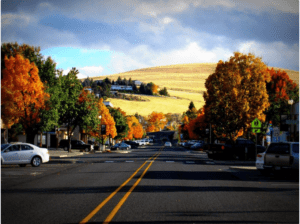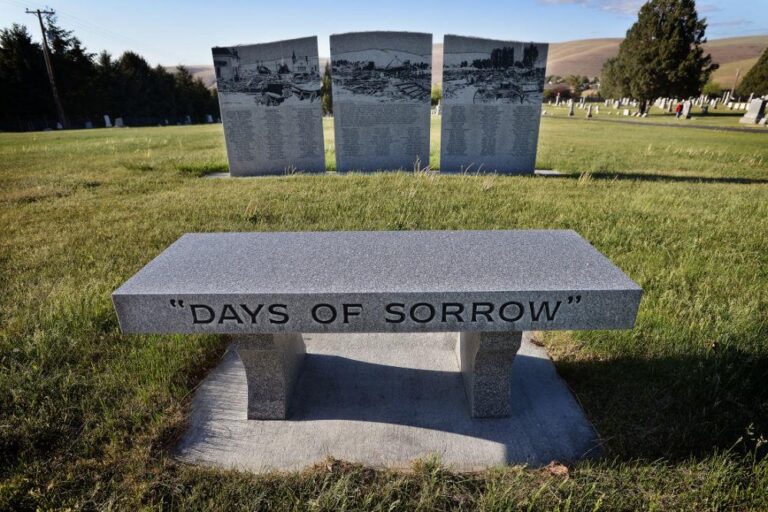Native American settlement
Native Americans lived and traveled along the land between the Columbia Gorge and the Blue Mountains for more than 10,000 years prior to European-American settlement. Ancient petroglyphs have been found approximately 45 miles (72 km.) north of Heppner in Irrigon and Boardman. In 1855, the U.S. Government and the predominant tribes in the region—the Cayuse, Umatilla, and Walla Walla—signed a treaty whereby the tribes gave up or ceded, to the United States more than 6.4 million acres in what is now northeastern Oregon and southeastern Washington. None of the tribes requested the council or wanted to surrender their lands, but representatives of the United States government championed the grand council and representatives of the tribes attended to protect their people and tribal interests.

The Umatilla, Walla Walla, and the Cayuse were very influential within the region in economics and politics of the Plateau due to their key geographical setting, halfway between the Pacific Coast and the Great Plains.
Learn more about the Cayuse-Umatilla-Walla Walla, the Confederated Tribes of the Umatilla Reservation, and their rich history here.
European-American settlement
Prior to Heppner’s founding in 1872, European-American ranchers used the area as sheep and cattle range as early as 1858. Records suggest these early cattlemen found abundant rye grass along creek bottoms.
Heppner was originally called Standsbury Flats for George W. Standsbury, one of the first European-American settlers in the area. In 1872, Colonel (Col.) Jackson Lee Morrow, a merchant, entered into a partnership with Henry Heppner, a prominent Jewish businessman, and they built a store on the crossing of the present May and Main streets. Soon thereafter, a mail and stagecoach line began operations between Pendleton, and the Dalles, and passed through Heppner.
Col. Jackson Lee Morrow was later elected to the Oregon legislative assembly and was instrumental in helping to carve out a new county for Heppner from neighboring Umatilla County and a portion of Wasco County. The assembly named the new county in Morrow’s honor.
Heppner was designated the temporary county seat at the time the county was created and narrowly defeated nearby Lexington in an election held in 1886 to determine the permanent county seat. Heppner was incorporated the following year on February 9, 1887.

In 1888, the Oregon Railroad and Navigation Company completed a railroad spur from the Columbia River up the Willow Creek drainage to Heppner. Pictured above is ORN Engine 57 and some officials in Heppner, OR.
The arrival of the railroad, celebrated with a jubilee, significantly increased the economic prospects of Heppner, which conducted a million dollars in trade in 1889, three times that of the previous year. Between 1880 and 1890, the town doubled in size, from 318 to 675 residents. The growth continued over the next decade when the population nearly doubled again. By 1900, 1,146 people called Heppner home.
By: Nathan Pederson

Pictured above is Henry Heppner, a prominent civil leader and entrepreneur. Heppner was born near Zerkow, Prussie in present-day Poland. Heppner emigrated with most of his family from Prussia to the United States c. 1849 most likely via Hamburg, Germany.

The Historic Morrow County Courthouse was built in 1902-03 and is one of the oldest continuously used courthouses in Oregon. In 1985, the courthouse was listed on the National Register of Historic Places.
The Flood of 1903
In the rolling wheat fields of north-central Oregon’s Morrow County lies the city of Heppner. Willow Creek meanders through the center of town, a stream that normally runs only ankle deep by mid-June.
After leaving its head-waters in the Blue Mountains, Willow Creek enters a narrow valley through the undulating, treeless prairies of the Deschutes-Umatilla Plateau, a semi-arid region receiving less than twenty inches of annual precipitation. The rains that do occur often come in the form of intense thunderstorms that can dump several inches in less than an hour.
The spring of 1903 was among the warmest and driest in memory for eastern Oregon. Sunday, June 14, was another hot day as Heppner‘s residents prepared for family suppers or evening church services. By mid-afternoon, dark clouds were building in the hills southwest of town. At 4:30 pm, rain, and then hail, began to fall. The storm produced such a noise people could not hear the roar of the wall of water and debris that descended on the town.
The Heppner Gazette reported: “Without a second’s warning, a leaping, foaming wall of water, 40 feet in height, struck Heppner at about 5 o’clock Sunday afternoon, sweeping everything before it and leaving only death and destruction in its wake.” The silt-laden floodwaters carried away everything in their path. The thick mass acted more like a battering ram than a flood of liquid. Homes floated off foundations and crashed into other structures, breaking apart and adding their debris to the flowing mass.
By the time the flood waters receded, most of Heppner’s residential area was destroyed and two-thirds of its homes were gone. The town’s business district was wrecked with all but three of the town’s businesses demolished. Newspaper reports gave disparate figures for the loss of life from the disaster. Early reports placed the death count as high as 500 persons. Eventually, 247 bodies were recovered, though many reports still list the casualty count at 251.
Many surviving residents left Heppner following the disaster. The 1910 census showed a population of 880, down from the 1,400 living there in 1903. It was not until 1990 that Heppner’s population rebounded to pre-flood levels.

While Heppner has experienced other floods since 1903, these events were relatively minor. A dam on Willow Creek immediately above town has protected the city since 1983. You can visit the dam and camp nearby at the Willow Creek RV Park and Campground. The Willow Creek Reservoir provides recreation for boating, fishing, and picnic.
“The Gateway to the Blues”
The small, frontier town of Heppner, located at the base of the Blue Mountains in Eastern Oregon, has a rich history of Native American culture, Oregon Trail settlements, agricultural land, and industry. It continues to be the generational home of many Swedish, German, and Irish immigrant families.

Today, Heppner is home to about 1,200 residents with many local businesses on their tree-lined Main Street. The Heppner Chamber of Commerce hosts an annual Irish festival on St. Patrick’s Day called A Wee Bit O’Ireland to commemorate the Irish roots of many founding citizens. The town also hosts the Blue Mountain Century Bikeway, an annual 108-mile bicycle ride in September, and hosts the over a century-old annual Morrow County Fair & Rodeo.
Visit Heppner and learn more by taking the Talking Rocks Historical Tour, visiting the Morrow County Museum, or taking a walk through Heritage Park.

Heppner Flood damage on June 14th, 1903. Oregon Historical Society Research Library

Heppner’s East Side, After the Flood – 1903. This view of the aftermath of the Heppner Flood was taken from Chase Street by local photographer Bert Sigsbee. It shows much of the area where many trees were flattened, and all the buildings were completely carried away.

In 2003, a three-panel stone monument was placed in town to mark the hundredth anniversary of the catastrophe. The monument, which includes a panoramic image of the destruction wrought by the flood and lists the names of the flood’s victims, serves as a reminder of Heppner’s day of tragedy.
